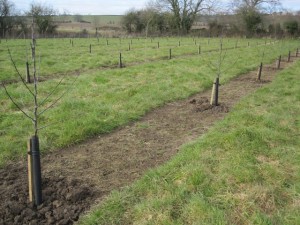The third and final phase of planting my 3 acre cider orchard is complete. The last 2 weeks of dry weather arrived just in time to allow me to plant the last 150 bare root trees, this brings the grand total to 490 trees in my orchard.
I am growing 10 varieties, a mix of bitter sweets, sharps and bitter sharps, these are new cider varieties resulting from a breeding programme, led by Pomologist Liz Copaz, at Long Ashton Research Station in the 1980’s . These new varieties have been bred for better disease resistance (particularly apple scab), earlier cropping (therefore extending the cider making season), more reliable cropping (as traditional varieties tend to become biennial croppers), and for bigger and juicier fruit!
Planning the orchard was a big task, I had so many decisions to make all of which would have very long lasting effects: which varieties, which rootstocks and what spacing. Phase I of the orchard (winter 2010/11) is planted on M106 rootstocks but I then decided that maybe MM111 would be more appropriate to the clay soil, this was the great advantage of planting in phases – learning from mistakes / acquiring more knowledge.
I have planted at an in-row spacing of 4m with 5m between the rows. All the trees have established well which is down to the excellent plants grown by John Worle, the use of mycorrhizal fungi and mulching at planting. Trees are staked and protected with vole guards (which also act against rabbits).
Next month once flowering begins, weekly orchard visits will be vital for early detection of any pest and disease problems.
The fruit from this orchard is being grown for Pilton Cider, a naturally sparking keeved cider which I defy you not to like!
